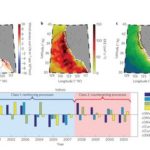Fangli Qiao from the First Institute of Oceanography in China gave this talk at PASC19. “In this interdisciplinary dialogue we will address such questions as – what is state-of-the-art in numerical ocean modeling? And what are the current trends in model improvement? We will consider several applications of the surface wave-tide-circulation coupled numerical ocean model, such as nuclear radiation spread prediction following damage to the Fukushima Nuclear Power in 2011, and the rescue of lives at sea after boats capsized near Phuket in 2018.”
HPC Connects: Mapping Global Ocean Currents
In this video from the SC17 HPC Connects series, Dimitris Menemenlis from NASA JPL/Caltech describes how supercomputing enables scientists to accurately map global ocean currents. The ocean is vast and there are still a lot of unknowns. We still can’t represent all the conditions and are pushing the boundaries of current supercomputer power,” said Menemenlis. “This is an exciting time to be an oceanographer who can use satellite observations and numerical simulations to push our understanding of ocean circulation forward.”
Simulating Sea Ice Leads at DKRZ
Researchers at DKRZ are using supercomputers to better understand the movement of sea ice. “Sea ice is an important component of the Earth System, which is often being discussed in terms of integrated quantities such as Arctic sea ice extent and volume.”
New Ocean Current Simulations Reflect Climate Change
Researchers are using the Gordon supercomputer at SDSC to paint a new picture of global warming’s impact on the complex processes that drive ocean mixing in the vast eddies swirling off the California coast. “Nearly a fifth of the worldwide ocean productivity is in these zones, and no one has really looked with this level of detail at the climate change implications for these precious marine areas,” said Renault.”







